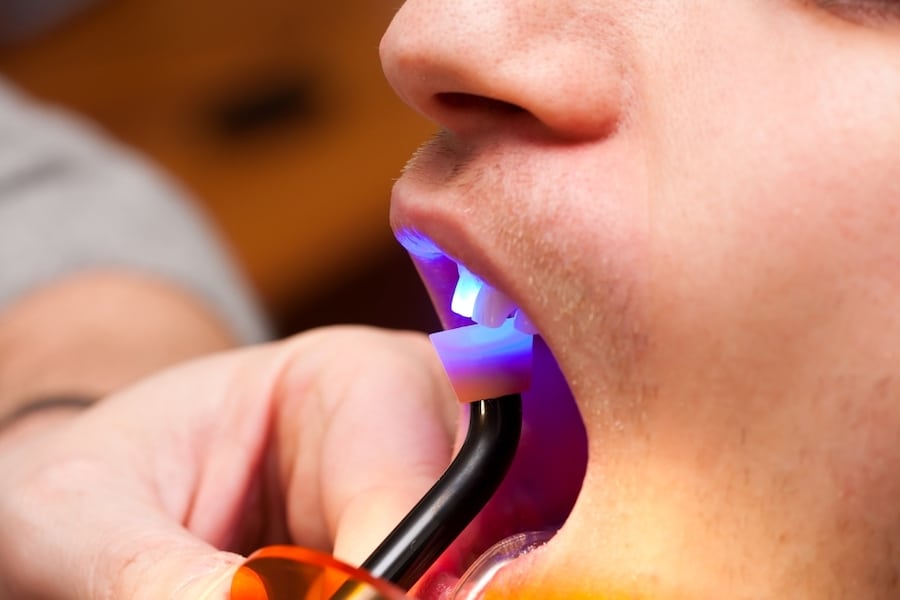Dental bonding is a cosmetic and restorative procedure. This kind of cosmetic dentistry is used to repair tooth damage while maintaining the look of natural teeth.
Teeth bonding involves your cosmetic dentist using a composite material, often in the form of a resin, to build up your tooth and hide imperfections. This material is cured using a bonding light, a process which bonds the material to the surface of your tooth.
As such, the final product is natural looking and quick, making a simple, non-invasive cosmetic procedure for those who are uncomfortable with their smile. Below is a quick overview list of the pros and cons of opting for cosmetic dental bonding.
Dental Bonding Pros
- Broken and Chipped Teeth: Dental bonding can fix problems in the front teeth in a way that other procedures cannot. And many times, it is less expensive than other procedures as well. As such, it is a quick remedy for damaged teeth– even when a large portion of the tooth was chipped away.
- Misshapen Teeth: As composite resin is mixed, applied, and cured all in the same appointment, bonding is a fantastic option for those looking to fix misshapen teeth in a time and cost effective manner. This procedure is especially useful for a too-short tooth or gaps between teeth.
- Discolored Teeth Are Covered: Your dentist has control over how opaque or translucent your bonding resin is. As such, it can be mixed to cover more stubborn stains and tooth discoloration.
- They Are Easy To Care For: Finally, bonded teeth are just as easy to care for as your natural ones. Simply stay proactive about oral health, brush and floss twice a day, and regularly visit your dentist.
Dental Bonding Cons:
- Longevity: Dental bonding is not a permanent solution because the bonding material is not as tough as enamel. You can extend the wear of your dental bonding by taking extra care of your teeth and avoiding chewing hard substances like ice and hard candy, but you’ll normally only get about ten years of wear from your dental bonding.
- Poor Pressure Resistance: While dental bonding is a great solution for front teeth, it isn’t usually recommended for making repairs to the premolars and molars. This is because the pressure undergone by back teeth when chewing will likely shake the bonds loose and potentially take some of the natural tooth along with it. As such, in cases where the back teeth are in need of the most repair, porcelain crowns and porcelain-fused-to-metal crowns are recommended as an alternative.
- It’s Less Effective for Multiple Teeth: While dental bonding is perfect for small repairs, it’s benefits begin to lessen when more extensieve work is needed. In cases where many teeth need work, a variety of crowns and dental veneers exist as an alternative treatment.
For cosmetic applications, it is generally recommended that thin porcelain veneers (such as Lumineers) are used so as to avoid the filing and tooth loss experienced when applying crowns. - Bonded Material Can’t Be Whitened: Teeth whitening procedures involve applying a peroxide mix to the teeth and letting it stay there long enough to seep through the enamel to oxidize pigment molecules in the dentin. Due to the material of the bonded resin, this process will not effectively whiten bonded areas of your teeth.
In Conclusion
The tooth bonding process is an art form. It’s success rests in the ability to match the resin to the shape and color characteristics of the surrounding teeth and further ensuring the bonded material cures securely. As such, it takes a great deal of time, training, and experience to perform the procedure well.
As with all dental problems, take the time to consult with a dentist you trust before you decide you need a particular procedure or solution. Established in the 1980s, EVDP takes great pride in having clients receive the best dental care and the best service.
If you are considering getting dental bonding or want to learn more about other options that may work for you, don’t hesitate to give us a call at: 480-838-3033.

